It was an impromptu gift—a book found by a relative on a discount table—that set Finn Meachem on a path that would lead him to a conference this summer to present research on pilgrimage sites in Java.
Meachem was a third-year student at Macalester College in St. Paul, Minn., with a double major in linguistics and religious studies, planning to study abroad on SIT Indonesia: Art, Religion, and Social Change in spring 2023.
There’s a lot of rapid social change going on in Indonesia and the voices of those people haven’t really been centralized in the classes I was taking or what I had learned so far.
“A relative of mine heard I was going to Indonesia, saw a random book and sent it to me. I read it because I was trying to find out as much as I could before I left, and it completely captivated me. So, reading that and then getting to formulate my own questions and go out there and get the answers for myself was incredibly satisfying. I mean, I’ve never been able to do that in my life before,” said Meachem.
That quest became a guide for Meachem’s SIT Independent Study Project (ISP) on how the religion of Islam got to Java. To investigate, he took his nascent Bahasa Indonesia and Javanese language skills and traveled on his own to the interior of Java to spend a month visiting several of what are believed to be the burial sites of nine Muslim saints.
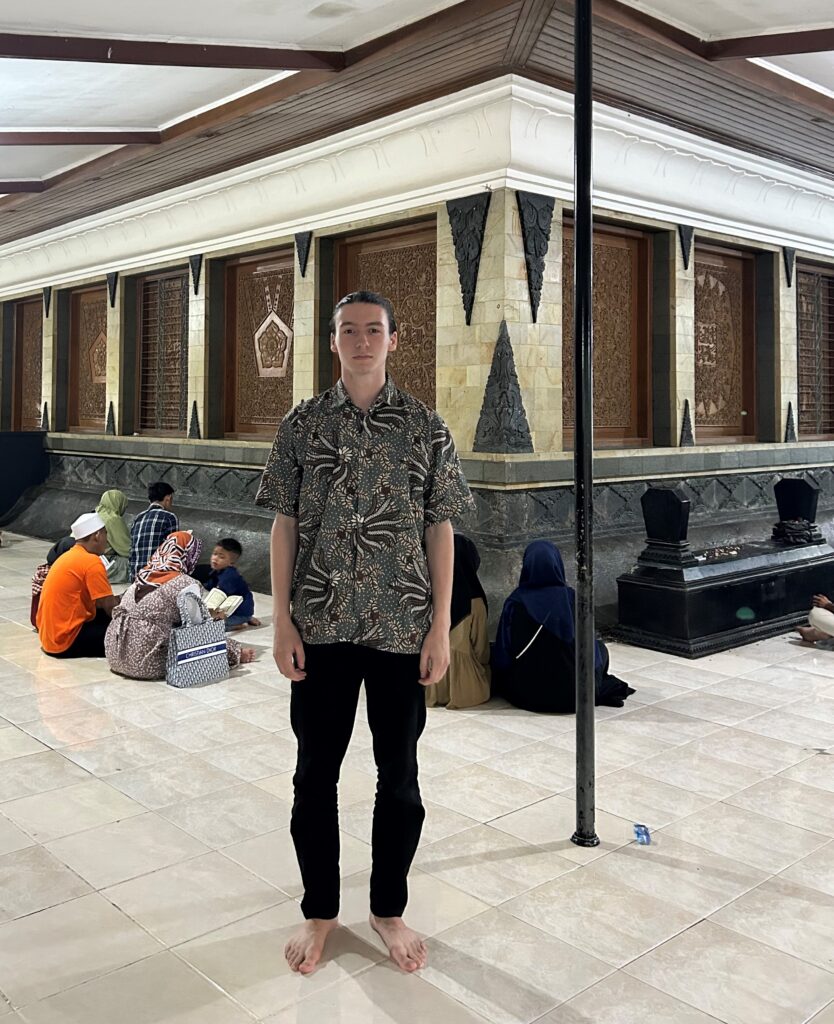
When he completed his research, SIT Indonesia Academic Director Ni Wayan Ariati recommended to Meachem that he apply to present his paper at the 2023 American Institute for Indonesia Studies (AIFIS) annual conference in July. Meachem was accepted to participate on a virtual panel called Unity and Diversity in Citizen Belonging.
“The quality of presentations was incredible. Even within our small group, it was enlightening to hear some of the other things people were talking about in Indonesian studies,” he said.
We talked with Meachem about his research and presentation, his experiences on the program, and what comes next for him as he enters his senior year at Macalester. Following are excerpts from our conversation, which have been edited for length and clarity.
Tell me more about your ISP.
My topic was how the religion of Islam got to Java. There are these nine quasi-mystical saints who are accredited with various miracles. The places where they’re said to be buried have become sites of pilgrimage. I visited as many as I could. I prayed there and talked with the key keepers of two of them. It’s a hereditary position that’s been passed down to one of their disciples, and then his son, and his son, and his son.
[These sites] act as a piece of infrastructure. They’re like a road or a highway or a toll bridge connecting one world to another.
So, my research was mostly about pilgrimage traditions and what I called spiritualized infrastructure: the idea that we have no proof of anything being at these sites. It’s just that they are necessary for a culture’s understanding of their own history and their own religion. They almost act as a piece of infrastructure. They’re like a road or a highway or a toll bridge connecting one world to another. They’re incredibly fascinating places to be. They are open to all, but they’re not really a place where people go. I was definitely not able to use any English for the month that I spent in the central Javanese interior. But it was incredible. I’m very glad I did it.
What language were you speaking?
I was speaking mostly Indonesian and the broken Javanese that I knew, which in general was enough. The dialect changes out there, but the SIT program did a pretty good job of preparing us to use Indonesian. I think it speaks volumes to the success of the program. I’m not anyone special, but I was able to just go out there and communicate my desires pretty effectively. I planned all the hotels by myself, and I planned the trip by myself. Faculty is there to help the people who need it. But if you feel like you’re ready, they’re ready to let your hand go and kind of let you ride a little bit, which is nice too.
Did you have an idea about your research before you went on program?
I had already had some scholarship opportunities and Macalester is really big on research and how to get approved for research, and the linguistics major also is very heavily focused on a research component. So, I was looking back at some of the old research I had done and forward toward my capstones. I wanted to do something that genuinely interests me and engages me. It would be a shame to work for an entire semester on a project and have it be a slog. So, part of it was circumstance—stumbling on these saints and their pilgrimage sites.
What’s the name of the book that your relative sent you?
The book is called The Bandit Saints of Java by Dr. George Quinn, who is an Australian anthropologist. I ended up Zooming with him. He’s an incredible person. He’s also visited the shrines. I love talking to him because he’s kind of the ultimate anthropology/humanities type person. His version of events was really interesting to hear, both as a preparatory thing before I went. And then I called him again after I had gone, to compare our experiences. Because I had read the book it felt so special to talk to him.
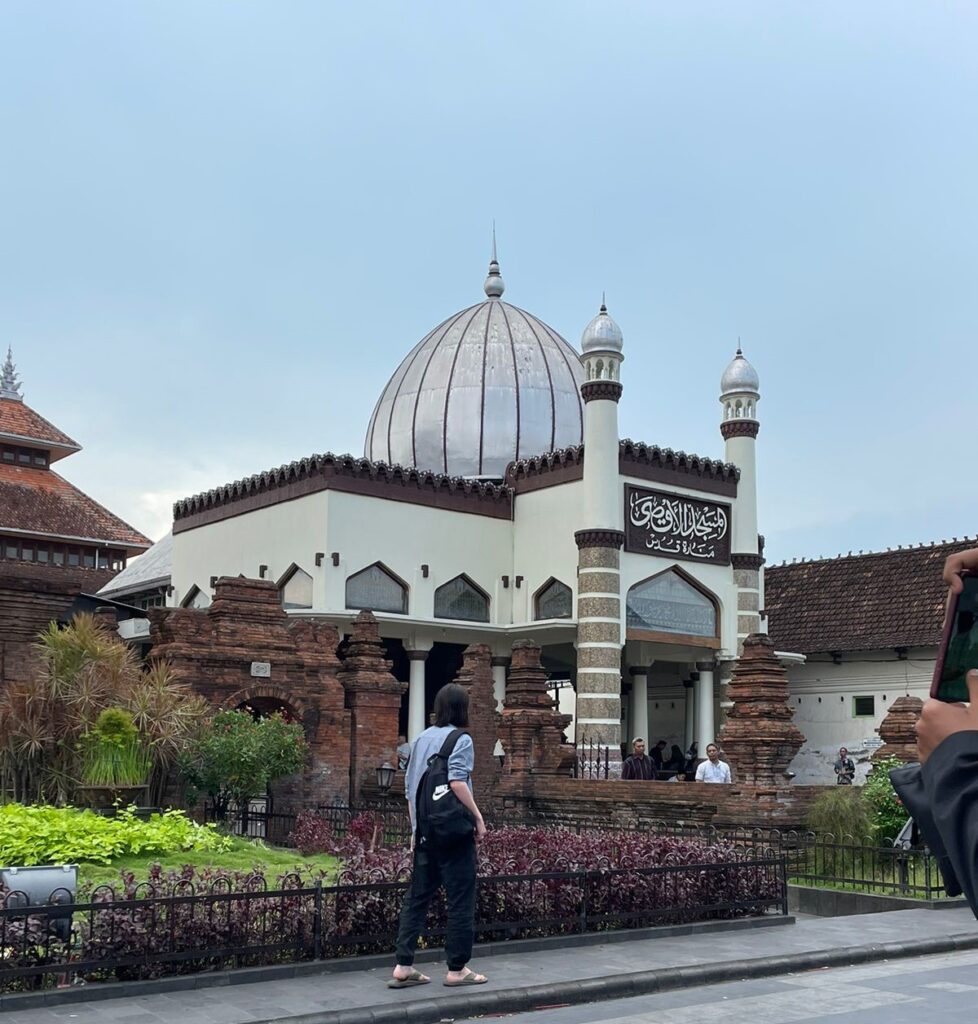
When you were looking for study abroad programs what were your criteria?
I knew that I didn’t really want to go to an English-speaking country. I didn’t have a ton of desire to go to the more common destinations or to see Europe or do something that was in my comfort zone. I was very interested in the multiple destination programs, but I realized for myself it would be best to stay in a place for as long as possible and really integrate myself into the culture and a family structure—to live with a family and learn the language.
I also knew I wanted to go to a place that was, not under-researched, but a place that was ripe for discourse, for things to study. There’s a lot of rapid social change going on in Indonesia and the voices of those people haven’t really been centralized in the classes I was taking or what I had learned so far.
The wonderful thing about SIT is the ISP component where I was just on my own for a month, and there was a ton of time to really get deep about things that tourists or travelers don’t often get to experience.
I had already done a little bit of research on Indonesia. My focus within religious studies is mostly Islam, and Indonesia is the largest Muslim country on Earth. I couldn’t picture Java or Bali beforehand, but I just thought this would be a very good way to try and integrate what I’ve been learning about and what I’ve been interested in. I just thought: It’s the right time in my life to take a leap. And luckily, I think it really paid off.
What do you think drew you to an experience like that?
Before I left, one of the things that really got me excited was reading about the history of civilizations on the islands of Indonesia. There’s a really rich history that I just had no access to. I didn’t learn that in public school. I think about the Maja dynasty or the great Hindu epics or the classical arts there. And there was this feeling, as the time approached, that I’m jumping into this and I’ve got a lot of catching up to do. There’s so much that I don’t know about this world. There were times where, especially when I first landed, that it really felt like another planet.
If I had to talk with somebody who is going next semester, I’d say just embrace it.
If I had to talk with somebody who is going next semester, I’d say just embrace it. It’s a very developed, civilized place. If you’re thinking about modernity or what you want out of your study abroad experience, you can go to a big city and there are hotels and casinos and big streets. If that’s your idea of what civilization is, you can find it there. But there are also places that look completely foreign to us, and they’re just as beautiful and in the modern world as the rest of the country. But there’s no real preparing for that, at least in my experience, just because there’s so much out there.
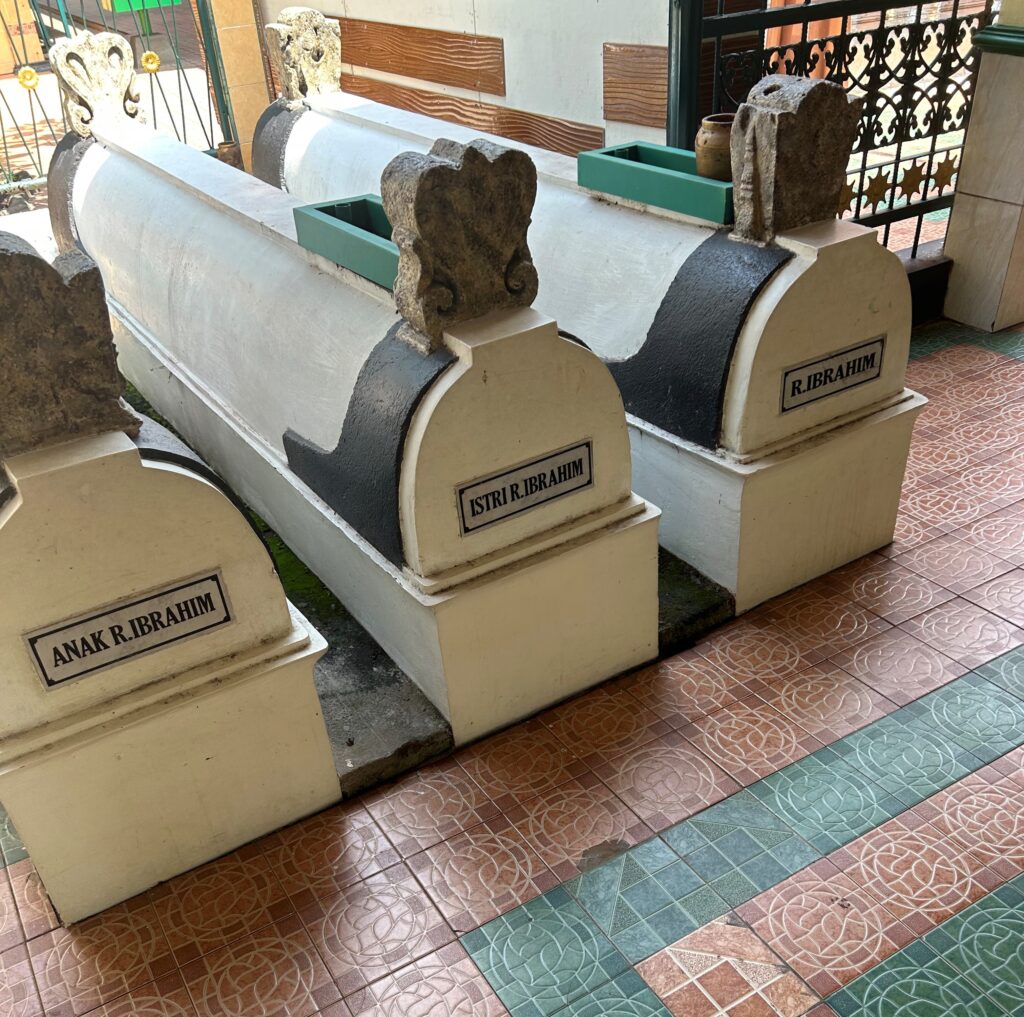
That’s what started to draw me to Indonesian studies: that maybe I should think about this after I come back, maybe I should make this into my life plan. I need to go back. I need to study it more because there’s 17,000 islands and each one of them is full of a culture that I know nothing about and is very worthy of study and education.
Do you know where you want to go with that?
This study abroad program helped me quite a bit with that. I think the immediate goal is to find a research fellowship or scholarship to go back to Indonesia because the research I did in Java has had more real-world application than I was foreseeing. I ended up presenting at the AIFIS conference, and I’ll be using some of the research I did in Java for my capstones. If there’s a way to research lesser-known religious discourse in the world of religious studies, I’d really love that.
Indonesia is also just a wonderful place to be in terms of linguistics. I think it’s the most linguistically diverse country on Earth. So, I’m going to hopefully get back there as quickly as possible and study the pilgrimage culture, which for me is this perfect intersection of language and religion.
Were there other things on the program that stood out for you?
Yeah, big props to the entire faculty for being so in-depth and available, and planning such good excursions. There was a wonderful mix of learning and free time to explore and also these planned excursions to important sites.
We had three homestays, but one was by far the longest—our homestead in Bali. I grew really close with my host family—just doing chores and learning to speak a foreign language—there’s a very real bond. I still keep in touch with them. If I ever go back, I will definitely visit them.
I’m going to remember the smaller things, like having a slice of cake and singing karaoke with my host families on my birthday.
We had amazing moments that were pre-planned, like going to these large temples. But when I think of spring 2023 and the SIT program, I’m going to remember the smaller things, like having a slice of cake and singing karaoke with my host families on my birthday. Just the small moments like that really were incredible. I’m glad everything was facilitated by SIT in a healthy, responsible way because it gave us the opportunity to connect with people that I never would have been able to connect with.
Did it change you, your experience?
Definitely. I spent Eid al-Fitr, the holiest day of the Muslim calendar, in a very rural part of central Java. I remember being invited to the parade and going and praying at the masjid and doing all of the typical things that Indonesian Muslims do—just kind of being carried along and trying to use the Indonesian that I could. But so many things stick out to me about life in those more rural parts of Java that changed my perspective on a lot of things. Since I’ve come back it’s definitely a little strange, but I feel very much at peace knowing that there’s so many interesting similarities in the human experience. And, no matter where I end up, those lessons will be applicable.
‘This trip has taught me so much about both the biological and political elements of conservation that will surely serve as a framework for my time back home in class and in the lab.’
By Scott Monahan
In summer 2022, Scott Monahan participated in SIT Indonesia: Conservation and Biodiversity in Bali and Borneo. Scott is a rising junior at San Diego State University majoring in evolutionary biology with a minor in statistics.

This summer, I studied abroad through the School for International Training on a program called Conservation and Biodiversity in Bali and Borneo. The program was six weeks long and focused on what makes Indonesia such an incredible spot for biodiversity, the conservation efforts to protect it, and the challenges they face.
Find out more about this program
Other than knowing that I wanted to study abroad this summer through a program related to my major, I started the study abroad process essentially clueless. I’d never left the United States before, didn’t have a passport, and had no idea where I wanted to go or how to get there. Although I was able to narrow down what programs seem interesting to me after a bit of research, I would’ve struggled to get much further if it weren’t for the help of the San Diego State University Global Education Office. They were really helpful in helping me prepare for every step of the process.

During my time in Indonesia, we had three research intensive weeks focusing on avian, forest and primate, and marine conservation. On top of these three subjects, we have also had our own independent field project to work on and collect data for whenever we best saw fit.
Avian Conservation
From our starting point, we would divide into groups of four, each equipped with a pair of binoculars and a journal. Each group would then walk down a designated transect for about an hour and a half taking notes of what species we saw, how many, their behavior, and any ecological trends we noticed. We’d then head back for breakfast while using a field guide to identify any unknown species we saw along the way.
The avian conservation segment of the project was the first section of the trip. At this point we were staying in Kerambitan district in southern Bali. An average day in this week involved waking up before sunrise, usually around 5:30 a.m. when the roosters started crowing, and walking to our observation location for optimal activity.
Around 9 a.m., we would have our first lecture of the day before heading out for the day’s excursions. For these excursions we’d visit national parks to learn the pros and cons of ecotourism, wildlife sanctuaries to learn about captive breeding programs, and cultural centers to learn about Indonesia’s diverse religious and ethnic makeup and how it relates to conservation. These outings took up the majority of our day and we wouldn’t get back until around 3 p.m. for lunch and a lecture on Bahasa Indonesia. Being on the equator, the sun would set pretty soon after our lecture. With each day being filled to the brim with activities, travel, and lecture, none of us minded going to bed early.
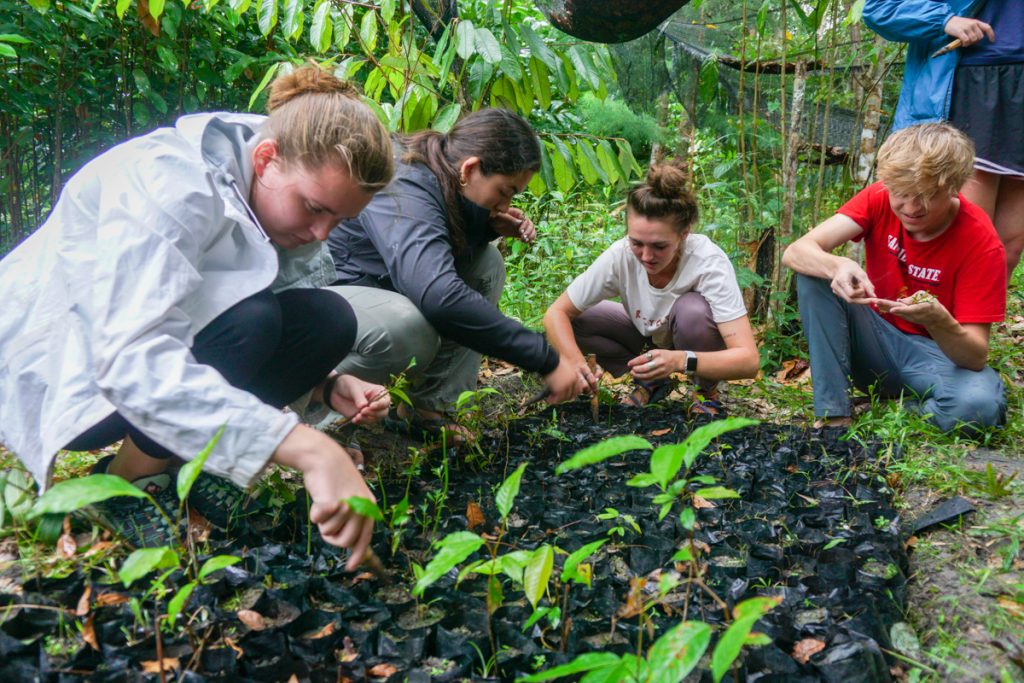
Forestry and Primate Conservation
The next part of the trip was dedicated to forestry and primate conservation in the heart of the Bornean jungle in central Kalimantan. We were staying at a reforestation volunteer housing center operated by the Friends of the National Parks Foundation (FNPF) that was about a two-hour boat ride from the nearest town.
This part of the trip was by far the most challenging, both because of the physically intensive nature of forestry conservation and the difficult living conditions. Other than the brief thunderstorms in the afternoon of each day, Kalimantan is incredibly hot and humid. For most of the early mornings we would focus on forestry restoration, usually taking a quick hike out into some secondary forest for a lecture on Borneon natural history.
After our lecture we would help with the reforestation projects, which involved cutting away patches of invasive brush and planting native saplings. This work was pretty demanding, so during the hottest part of the day we would break in the shade for Bahasa Indonesia class. After class, we would have another hike into the secondary forest to collect tree seedlings to replace the stock that we planted in the nursery.

On our lighter days we would take a boat to a forestry preserve to look for wild or rehabilitated primates that were released by the FNPF. Along these hikes we usually saw orangutans, long-tailed macaques, gibbons and proboscis monkeys. On these excursions, we learned about orangutan biology, what makes them a keystone species, and the conservation issues they face.
During this section of the trip I also decided that Kalimantan was a great research location for my independent research project. I wanted to do something conservation-related and I have a personal interest in entomology, so I decided that I would do a population analysis of terrestrial arthropods in the area and look for trends between population size, biodiversity, and anthropogenic impact to determine the value of insects as indicator species.
I had seven locations (ex-gold mining site, palm oil plantation, river, reforestation site, volunteer housing, secondary forest, primary forest) where I installed pitfall traps. After letting the traps sit for a day, I collected all of the specimens and moved on to the very long and very tedious process of species identification.
For this part of my project, I used my macro camera and a millimeter ruler to take ventral, dorsal, and lateral pictures of each species while keeping track of the number of individuals from each. Because of the remote location, I didn’t have forceps and instead had to use a pair of porcupine quills to position them. This took a good amount of time, during which I was getting eaten alive by mosquitos, but by the end I had ~100 good-quality photos.

Marine Biology Conservation
Following our forestry and primate section, we traveled to a small island off the coast of Bali called Nusa Lembongan. Here we worked with a marine biologist from Australia who has been doing reef conservation in the area for 12 years. A major issue in the area is physical damage to reef structures from boat docking. This creates an unstable environment that makes it much harder for coral to develop in the area.
After a few lectures on ocean science and coral biology, we helped make and prepare several tent-shaped rebar structures that act as a stable site for corals to grow on. The next day we snorkeled at their coral nursery to collect fragments to attach to our structures. After this, we installed our structures on sites deemed suitable for the species we collected.
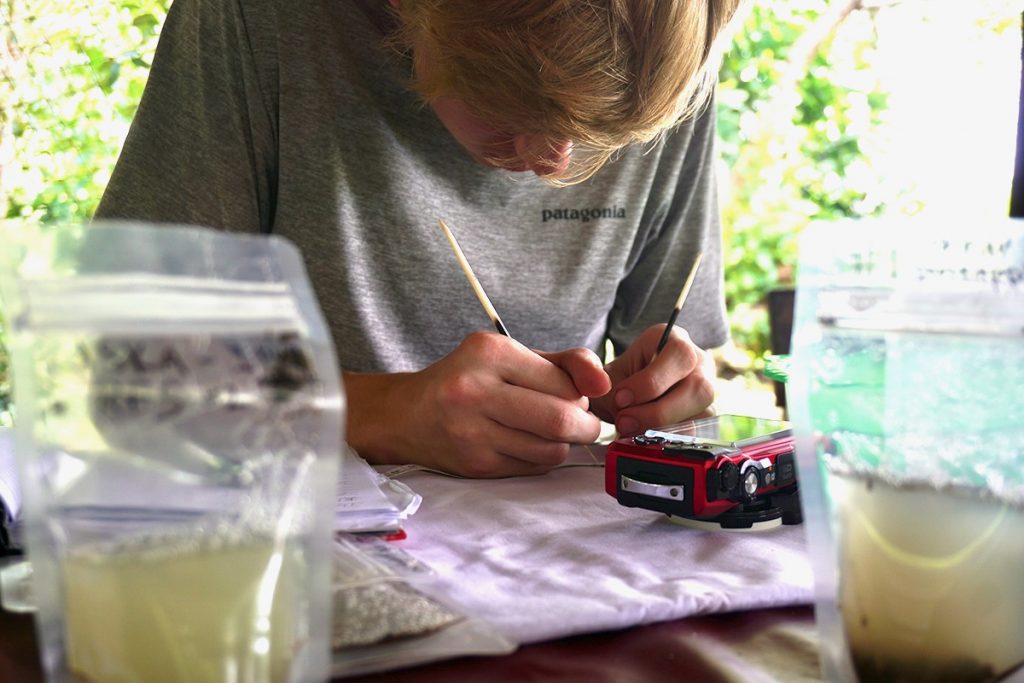
No pictures or videos could ever do this snorkeling trip justice, and it’s even harder to convey through words. Seeing these incredible creatures swim over a thriving reef teeming with countless species is something I’ll never forget.
Nusa Lembongan also has a local population of manta rays, so the next portion of our marine conservation section was dedicated to their biology and conservation. After our lectures we took a boat out to Manta Bay where we got to snorkel with three juvenile manta rays, one of which was a rare all-black manta.
No pictures or videos could ever do this snorkeling trip justice, and it’s even harder to convey through words. Seeing these incredible creatures swim over a thriving reef teeming with countless species is something I’ll never forget. We finished this trip up around 1 p.m. and had the rest of the day off. We always loved having an afternoon just to lay around the beach and relax, but this one was particularly appreciated because it was also my birthday. I’ve heard 21st birthdays are pretty great, but I think I’m going to have a hard time topping this one.

Memorable Moments
I’ve been on a lot of great hikes on this trip, but by far my favorite was when we climbed a volcano in Java called Kawah Ijen. Ijen is incredibly rich with sulfur, so much so that any fire that forms from the volcano’s immense heat burns blue, a phenomenon that only occurs in two places in the world. In order to see this blue fire, you have to make it to the inside of the crater while its still dark. To accomplish this, we had to wake up at 1 a.m. to make it to the Ijen basecamp by 2 a.m. to gear up.
Hiking up Ijen is pretty difficult due to it being dark and incredibly steep, and hiking down into the crater is no easier. Due to the sulfur concentration, once you get over the ledge you have to put on a gas mask to breathe. After about four hours of hiking, we finally reached the lowest point and saw the blue flames spewing from a heat vent. Although the fire was incredible, I was a bit distracted by the fact we had to repeat the already challenging hike back up, but this time in gas masks.
Any fire that forms from the volcano’s immense heat burns blue, a phenomenon that only occurs in two places in the world.
Somehow we managed to make it back up to the ridge of the crater just in time to have the breakfast we had brought with the best sunrise I’ve ever seen. As the sun came up, we were able to see all the details that were lost to us in the night. One that we had walked along without even noticing was a lake about 1,000 feet down in the crater. The lake is an unbelievably bright teal color painted with yellow streaks due to the high concentration of sulfuric acid within it, such a high concentration that the pH of the water is only .3.
This trip has taught me so much about both the biological and political elements of conservation that will surely serve as a framework for my time back home in class and in the lab.
Although I was already planning on going to graduate school for biology before this trip, my experiences here, both the highs and lows, have really solidified in my mind that I’m on the right path.
This blog post was originally published on the San Diego State University College of Sciences website. It is reprinted here with permission. All photos courtesy of Scott Monahan.
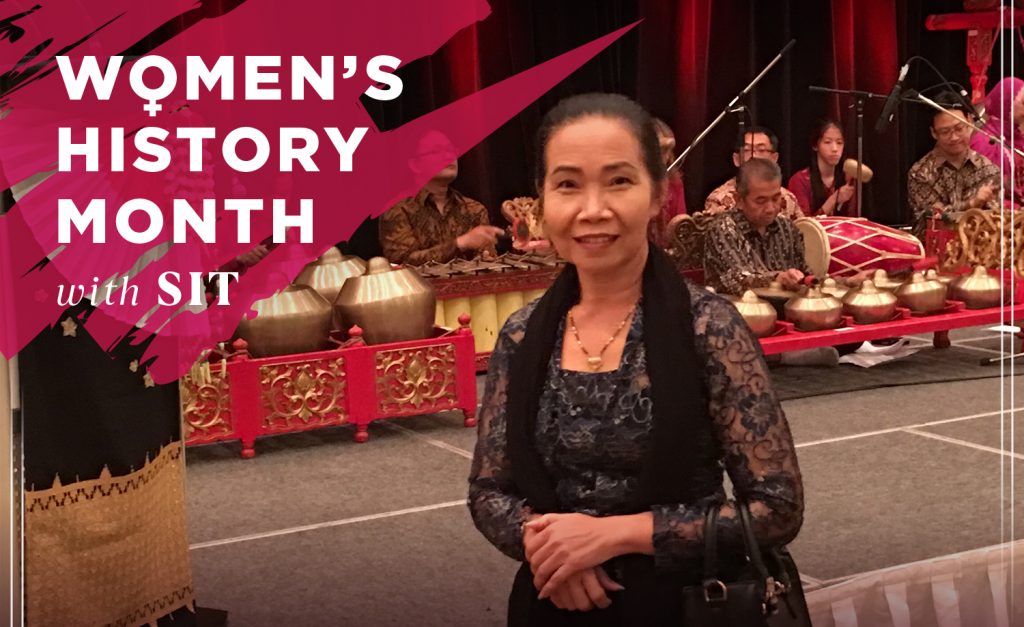
During Women’s History Month, SIT spotlights some of our extraordinary faculty, staff, and alumni across the globe who are making history today through their thinking, their words, and their actions.
Ni Wayan Pasek Ariati (Bu Ary)
Academic Director
SIT Indonesia: Arts, Religion, and Social Change
If you could chat with any woman in history, who would it be and what would you ask her?
Helen Keller (1880-1968), an American author and activist who inspired many with disabilities to gain high achievements. Although she lost her sight when she was only 18 months, it didn’t stop her from being famous and legendary in this world. The most important quotes that fit into our program are, “Life is either daring adventure or nothing at all.” And, “Optimism is the faith that leads to achievement. Nothing can be done without hope and confidence”
My questions to Helen Keller would be: What motivated you to overcome your handicap to gain high achievements in your life? How did you overcome all those obstacles? What was your advice for people with disabilities to face this life?
Also, Raden Adjeng Kartini (1879-1904), an Indonesian heroine who fought for equal right for girls and women in higher education. She was born during the Dutch colonial period in Indonesia. Her famous book, “Habis Gelap, Terbitlah Terang,” (“After the Darkness, comes the Light”) is a collection of her letters to her pen pal, Ms. Abendanon.
My questions to her would be: What was the main motivation for you to advocate equal rights in education for girls/women? What’s your advice to Indonesian’s people in treating their daughters?

What do you consider to be a significant step toward gender equity?
Appointing a native Indonesian woman in a leading role as the academic director for the program. By having a native woman as academic director, we can show people that our institution is inclusive and appreciates diversity in giving the opportunities to the minority under presented people.
What are some of the greatest challenges to gender equity in your country?
Changing the public mind-set that only men or western people can do a better job at the same field, and convincing communities that women can also do great jobs as the men can do.
What lived experience has had the biggest impact on your career (or your life)?
Doing my doctorate degree on comparing one of the Hindu deities, the Goddess Durga as a warrior goddess. Having a doctorate degree on my ID card has changed people’s views about me and women in general — especially when I inform people that I received a scholarship to do my higher education and my doctorate degree.
What advice would you offer a young woman looking to enter your field?
Try to be strong in facing this life. Pursue your education as high as possible so that you can explore the world by sharing your knowledge. Find scholarships to get your doctorate degree and get work experience as much as possible. Dedicate yourself to your work and try to enjoy whatever you do, no matter how hard it is.
What are your main goals as an educator?
My main goals as an educator are to inspire young people to be resilient, tolerant, respectful toward differences and appreciative of the beauty of diversity. I also would like to produce young people with various skills, not only through formal education but also from their life experiences.
Edo joined SIT Study Abroad Indonesia in 2014 as program assistant. He teaches Indonesian Language for the beginning level. Edo completed his bachelor’s degree English at Udayana University.
Dian joined the program in 2016. She completed her BA in English at Warmadewa University, Denpasar, Bali. In addition to teaching Indonesian language, she also is helpful in organizing student visa extension and as the main contact for Yayasan World Learning Indonesia.
Yudi joined the SIT program in Bali in 2001. He completed his BA in English at Udayana University the following year. Before joining SIT in Bali, he worked for many years in the NGO field, especially for Bali Hati, an NGO specializing in educational support for children of lower income families in Gianyar and Badung regencies. Yudi devotes much of his free time to mastering English and often provides assistance to local institutions delivering English language courses to native speakers of Indonesian.
Applications open Sept. 15
With undergraduates’ schedules in full swing for the new academic year, it’s not too soon to start thinking about how to make the most of summer 2019. Imagine snorkeling in one of the world’s top diving sites as you study marine ecology in Panama, building career skills with an internship at an NGO in Vietnam, exploring Madagascar’s extraordinary natural environment to learn about traditional medicine, or learning Arabic in Jordan or Morocco.
Those are just some of the many opportunities available through School for International Training (SIT). During summer 2019, SIT Study Abroad is offering 23 programs in 17 countries that will appeal to a wide range of majors and interests, including five skills-building internship opportunities.
Like all SIT Study Abroad programs, each summer program offers academic rigor and an immersive cultural experience within the framework of at least one critical global issue. Applications for these programs open September 15.
New to the SIT Student Abroad summer portfolio this year are:
Colombia: Building a Culture of Peace – Integrate peace studies with Colombia’s cultures through music, dance, and food from the program base in the vibrant, multicultural Caribbean Coast city of Cartagena, a UNESCO World Heritage site.
Vietnam: Nongovernmental Organization Internship – Learn about development and the roles of nongovernmental organizations engaged in social change through this guided internship, which also includes lectures and site visits. Customize this program based on your areas of interest.
SIT summer programs, sorted according to themes, are:
Climate | Environment
Iceland: Renewable Energy, Technology, and Resource Economics
Indonesia: Biodiversity and Conservation in Bali and Borneo
Jordan: Engineering and Design for Sustainable Environments
Nepal: Geoscience in the Himalaya
Panama: Marine Ecology & Blue Carbon Conservation in the Pacific & Caribbean
Tanzania: Climate Change and Sustainability, Mount Kilimanjaro to Zanzibar
Development | Economy | Inequality
India: Agroecology and Food Security in the Himalaya
Panama: Community and Nongovernmental Organizations Internship
Vietnam: Nongovernmental Organization Internship
Global Health
China: Community Health and Traditional Chinese Medicine
India: Traditional Medicine and Healthcare Practices
Jordan: Counseling and Humanitarian Action Internship
Kenya: Public Health in the Tropics Internship
Madagascar: Traditional Medicine and Healthcare Systems
Switzerland: Food Security and Nutrition
Media | Arts | Social Change
Argentina: Art, Memory, and Social Transformation
Migration | Identity | Resilience
Jordan: Intensive Arabic Language Studies
Morocco: Arabic Language and Community Service
Peace | Human Rights | Social Movements
Colombia: Building a Culture of Peace
South Africa: Education and Social Change
South Africa: Social Justice and Activism Internship
Switzerland: International Studies and Multilateral Diplomacy
Uganda and Rwanda: Peace and Conflict Studies in the Lake Victoria Basin
Visit our website for more information on these and all of SIT’s immersive, experiential study abroad opportunities.
